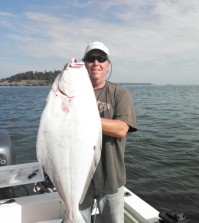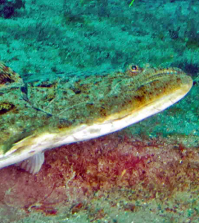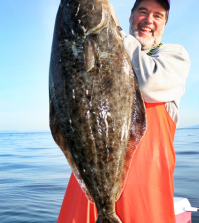It’s Almost Halibut Time!

Although it has 31 days, May seems like the shortest month of the year to many of Washington’s halibut fishermen. With the exception of the extreme south Washington coast, our halibut seasons here in the Evergreen state are limited to a handful of days during the fifth month of the year. And, as if those painfully short seasons weren’t enough to put extreme pressure on anglers trying to be in the right place at the right time, most of our productive halibut spots are now all open on the same weekends, so you can’t jump from one area to another as seasons close in one part of the state and then open somewhere else.
Bottom line: it’s now more important than ever to do your homework before the season to increase your odds of finding fish when May rolls around.
We have worthwhile halibut fisheries the length of the Washington coast (Marine Areas 1-4), the Strait of Juan de Fuca and San Juan Islands (Marine Areas 5-7) and—sometimes—the north end of Puget Sound (Marine Area 9), but that doesn’t mean that your chance of catching fish on any given day is as good in one area as it is in any of the others. Weather, tides, baitfish populations, even availability of boat access in the place you plan to fish are among the factors that might determine whether your day on the water is a good one or a bad one.
Let’s take a closer look at those halibut spots, marine area-by-marine area, to help you decide where you might want to be when May rolls around.
For starters, don’t waste your time thinking about fishing southern Puget Sound or Hood Canal. Areas 11, 12 and 13 are closed to halibut fishing again this year, and you wouldn’t be very likely to catch one even if it were open. There would be a greater chance of catching one of the south-sound’s quickly disappearing rockfish species, so to help protect rockfish and keep us from wasting valuable halibut-fishing time, Washington’s fish managers have closed the Canal and southern Sound to both.
I’m not sure why, but halibut fishing is allowed in Marine Area 10, even though the rockfish season is closed there, too. You might have a slight chance of stumbling into a halibut along the edge of the drop-offs at Apple Cove Point or Jeff Head, but I wouldn’t waste the few precious fishing days we have prospecting for flatties in MA 10.
Your chances of finding an early season halibut improve somewhat if you move north to Area 9. In fact, there have been some pretty impressive catches from places like Midchannel Bank, Mutiny Bay and Double Bluff in the not-too-distant past, but most of those came when the season was open earlier than it is now. The bait that drew those fish into the north end of the Sound tends to disappear by May, and when the bait is gone, so are the halibut.
The same goes for Marine Areas 6 and 7, where anglers wish the sport halibut seasons opened in March or April rather than in May. Earlier in the year, when candlefish (sandlance) and other baitfish are abundant on Hein Bank, Middle Bank and other underwater humps along the east end of the Strait of Juan de Fuca, the halibut are there, too, feasting on the little forage fish and growing heavier by the week, but that feeding frenzy tapers off by early May, as the marauding halibut start making their way back toward the greener pastures of the Pacific.
Luckily, they aren’t all gone at once, so there are fish to be had by anglers willing to put in the time. The drop-offs around Partridge Bank, Smith Island and Eastern Bank are worth investigating, especially at the start of the season.
To the south, I like to fish the north end of Dallas Bank on a flood tide and the west side of the bank on an ebb. The west side of Dungeness Bank can also be worth fishing on an ebb tide, when you can work your way down-hill with the current.
A few miles north of Dungeness lies Hein Bank, which is carpeted with candlefish earlier in the spring and where there are usually halibut lingering into May. I like to work a bait rig down the northwest side of Hein on an ebb tide and prospect with jigs along the south end and southeast side on both the high and low slack.
Farther north, the waters around Middle Bank also produce halibut, especially the drop-offs along the northeast corner. The bottom can be pretty rough and “grabby” in some areas along the east side of Middle Bank, so don’t let your rig drag bottom as you drift. To the east, where the US/Canada border makes a more westerly turn, lies Coyote Bank, another one I like to fish on the ebb tide, drifting from east to west as I make my way down the south side of the bank.
Anglers launching out of Sequim or Port Angeles who want to stay a little closer to the beach might find a halibut or two along the edge of Green Point or run a couple of miles northwest to the hump known as 31-36. Speaking of humps, there’s a spot to the northwest of Ediz Hook named The Humps, known not only for its winter blackmouth fishing but also for giving up a halibut or two during the spring season.
The 2015 version of halibut season in all the aforementioned spots along Marine Areas 6-10 will be 11 days long again this year, starting May 8 and 9 (Friday and Saturday). There will be another Friday-Saturday opening May 15 and 16, and four days of fishing May 21-24. Our final shot in areas 6-10 will May 28-30.
Halibut fishing in Marine Area 5 has, in past years, opened a little later and closed a little later than areas to the east, giving anglers a chance to head off westward-bound halibut from Sekiu after areas 6-10 closed, but not so this year. Area 5 halibut anglers will have only eight days to fish, May 15 and 16 (Friday and Saturday), May 21-24 (Thursday through Sunday) and May 29 and 30 (Friday and Saturday). Slow-trolling or drifting bait off the mouth of the Twin Rivers produces some halibut for Area 5 anglers, but the 240-foot line off the mouth of the Hoko River (Kydaka Point) is a better-known Sekiu-area halibut spot. In recent years it has produced a lot of smaller fish, but over the years this spot has given up its share of really husky halibut.
If Washington has one place that could be described as a halibut-fishing mecca, it would have to be Marine Area 4, the waters of the Pacific Ocean and western end of the Strait of Juan de Fuca around Neah Bay. Not only are there good-sized halibut to be found in near-shore spots like Koitlah Point (affectionately known as the Garbage Dump), Duncan Rock and Tatoosh Island, but Swiftsure Bank and other offshore humps have provided excellent halibut fishing for 30 years and continue to do so now. The main problem here is that those offshore hot spots are so productive that anglers achieve the season quota of halibut in a matter of a few days, and then it’s all over.
It’s the same in Marine Area 3 to the south, where most anglers depart out of LaPush. There are several near-shore humps that produce a few halibut, but most LaPush anglers head to the happy halibut grounds some 30 miles offshore where, as in Area 4, the fishing is so good that anglers catch their season quota in a couple of weekends (or less). That might be a good thing, from a medical standpoint, as it saves anglers from spending too many days bouncing bottom with three-and four-pound sinkers and hauling halibut up from depths of 400 to 600 feet or more.
The halibut season for Marine Areas 3 and 4 this year opens for up to two weekends beginning May 14, Thursdays and Saturdays only, and will close when the catch quota is achieved. If you’re thinking about fishing either area for the first time, be sure to check the fishing regulations pamphlet for details on the large, C-shaped closure area that includes part of the southern end of Area 4 and part of the northern end of Area 3.
Area closures and depth restrictions are also a factor for halibut anglers in Marine Area 2 (Westport), where good fishing on the offshore halibut grounds of Grays Canyon resulted in anglers’ reaching the catch quota early last year. As the name suggests, this is a deep-water fishery where you might find yourself reaching for bottom at depths of 600 to 700 feet. There’s also some halibut-fishing opportunity on inshore humps to the north and south of Westport, but that fishery also closed early the past couple of years when the overall area quota was reached (because of the offshore fishery). The Westport-area halibut season opens May 3 this year, with fishing allowed Sundays and Tuesdays only offshore. Be sure to check the WDFW fishing pamphlet and the agency website for details on those closure areas and other bottomfish restrictions.
The halibut season in Marine Area 1 at the south end of the Washington coast opens May 1, with the offshore fishery running Thursday through Sunday and a near-shore fishery along the length of the Long Beach Peninsula is open Monday through Wednesday. Like the other coastal seasons, the south coast closes when the catch quota is reached.










